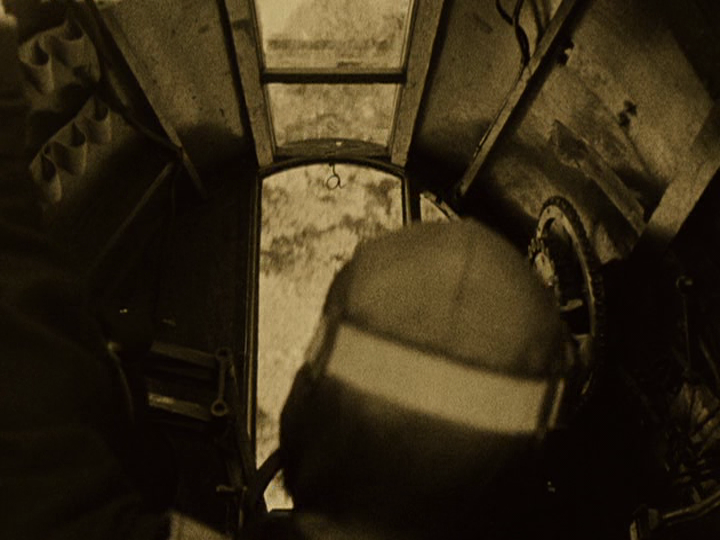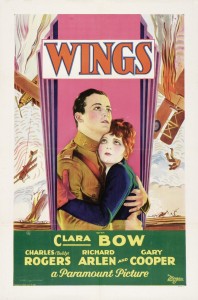|
Genres, Themes, Actors, and Directors:
- Airplanes and Pilots
- Clara Bow Films
- Gary Cooper Films
- Love Triangle
- Silent Films
- William Wellman Films
- World War I
Response to Peary’s Review:
As Peary notes, this “grand-scale silent classic” — directed by “former pilot William A. Wellman”, and winner of the first “Best Production” Academy Award — is “known for some truly spectacular dogfight sequences”, as well as “some amazing stunt work and aerial photography”. He points out that the “picture is beautifully filmed throughout” — particularly “Wellman’s revolutionary boom shot at the Paris cafe in which his camera zooms over several tables into a close shot of the drunk Rogers and Arlen with some French trollops” — and notes that “the sweeping final battle — on land and in air — is remarkable!” He argues that the “film’s major problem is that… the leads have little screen presence”, and that “today the film seems a little slow — but the brutality seen in the impressive war sequences keeps it timely”. In his Alternate Oscars book, Peary reigns back his enthusiasm a bit further, asserting that Wings “pales in comparison with [F.W. Murnau’s] Sunrise” (which won an Academy Award for best “Artistic Quality”), as well as King Vidor’s “The Crowd and Charles Chaplin’s unnominated The Circus;” he argues that the film has “dated badly” given its “weak [lead] performances, an overly peppy Clara Bow, and long flight sequences in which you can’t tell friend from foe”.
Actually, the points made in both of Peary’s assessments ring true. While the storyline itself remains as simplistic and cliched as that found in (far too) many silent films, Wellman’s overall craftmanship can’t be denied — and the aerial sequences are undeniably stunning. Knowing that all the stunts and effects were achieved in real life (no CGI to fall back on!), one simply marvels at the audacity of both Wellman’s vision and his intrepid crew (Rogers and Arlen actually learned to fly); viewing the 35-minute “making of” documentary on the recently restored DVD version of the film gives added insights into exactly how risky (and innovative) much of the filming was. Meanwhile, the non-aerial battle scenes are just as impressive, and rival those found in King Vidor’s The Big Parade (1925). Regarding the lead actors, I actually find Rogers’ performance adequately charismatic, and handsome Arlen’s appropriately subdued (especially given that he’s holding onto a powerful secret the entire time); poor Bow’s character is simply put through the ringer — but so it goes, I suppose, when you’ll do anything for your man.
Redeeming Qualities and Moments:
- Truly amazing aerial camerawork

- The impressively shot battle sequences

- Fine overall direction by Wellman

Must See?
Yes, for its historical relevance and for its still-stunning aerial sequences.
Categories
- Historically Relevant
- Oscar Winner or Nominee
Links:
|




One thought on “Wings (1927)”
A no-brainer must – quite possibly being in the top 10 best of silent films.
Regarding Peary’s quoted (negative) remarks about this film…I could not disagree more! (It pales in comparison with ‘Sunrise’??? He can’t be serious!) Coming from someone who is very tough on silents and war films, I feel ‘Wings’ is quite impressive as both – actually, it has such impact that you shouldn’t feel surprised at times if you forget completely that you are watching a silent film. At almost 2 1/2 hours, the time flies by effortlessly. As shot by DP Harry Perry and his considerable crew of cameramen (13 total), ‘Wings’ – almost shot by shot – is a visual wonder, keeping us in its grip even during low-key sequences. (But, of course, it’s Perry’s guidance through the ‘How did they shoot that?!!’ shots that does not fail to astound.)
It’s easy to see why Wellman would choose this as his personal favorite among his films – it’s just about perfect. Not only does it pack a definite wallop often but it is quite unashamedly heartfelt when it needs to be. (Note, in particular, the easy affection displayed between male characters; note Bow’s restraint when she has an easy opportunity to get ‘revenge’ on Rogers, before deciding against it; not also, in the Parisian cafe zoom shot…don’t blink or you’ll miss the matter-of-fact lesbian couple as part of the open crowd.)
One has to suspend a touch of disbelief as the film reaches its conclusion – but that’s of small importance. ‘Wings’ delivers from its opening title sequence – and its inter-titles are among the most intelligent and well-written that I’ve seen for silent films.
The three leads are just fine (each possessing wonderful screen presence) – giving consistently interesting performances.
When films started coming out in VHS format, silent films were not always found as prints that were in great shape. As re-issued last year on DVD, the print available now is pristine and it comes with an excellent score and judicious use of sound effects. For a film made in 1927, ‘Wings’ remains potent. urgent and simply splendid storytelling.
I also recommend the DVD’s ‘making of’ documentary. The backstory of this film is quite interesting and it’s all there in vivid detail.